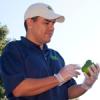Hello Melsky.
If you are in the USA, all food contact chemicals should be labeled for the intended use, in this case, the chlorine is considered a pesticide and should be labeled for use in vegetable wash. The problem is that not a lot of liquid chlorine brands (Sodium Hypochlorite) are labeled for produce/vegetables. Do not buy “Clorox”since it may have lower concentration and/or fragrances.
The brand we use is called AGCLOR 310. It is just sodium hypochlorite at 12.5%, but is labeled for produce. The manufacturer is DECCO www.deccous.com (not endorsing or not affiliation).But you can look for other suppliers such as Ecolab (as recommended byBawdyo1).
Now, Chlorine is an effective and low cost chemical to use in produce wash, BUT it needs to be controlled and you need to know what you are doing. First, you need to keep the water pH, and normally would have to use an acid solution to keep the optimal pH.(Citric or Phosphoric Acid). Then you need to control turbidity (how clean is the re-circulating water) and of course you need to measure the free or active chlorine (not the total chlorine). How you do all this depends of your operations, so you need to do some test and validations.
Here are few good resources:
Chlorine use in produce packing lines: http://edis.ifas.ufl.edu/ch160
Chlorination of Water for Fluming and Cleaning Fresh Fruits and Vegetables and CleaningEquipment: http://onfarmfoodsafety.org/wp-content/uploads/Chlorination-of-Water-for-Fluming-and-Cleaning-Fresh-Fruits-and-Vegetables-and-Cleaning-Equipment.pdf
Hope that helps.
Dear Antores,
Thks for the interesting links.
It's not really my area but i noticed the recommendation in the 2 documents was considerably different regarding the target level of
free (available) Cl2,ie 2-7 ppm in Canadian case compared to 100-150 ppm in US case.
Is this because the recycle functions are typically being run in a different way, eg maintaining different amounts of organic material, or difference in perceived pathogen "killing" requirement, or simply that the US likes to use a lot of "chlorine" ? I do remember that most vegetable
HACCP plans I have seen typically have a
CCP (or control level) for the wash water stage nearer to the lower range mentioned above.
I noted the caveats regarding choice of calcium hypochlorite in weblink. IMEX with plant water chlorination systems, the author was maybe optimistic. It has an advantage in being available in a solid form as long as one can tolerate the constant odour of Cl2 when handling. But it can also be extremely effective in blocking lines due to the generation of insoluble solids. Rather than adding a preliminary sedimentation unit I gave it up after a few months and switched to NaOCl solutions, problem solved.
Other commercial Cl2 washing sources for vegetable growing have also been discussed in this forum. From memory there is a long thread here on the use of isocyanate (?) based tablets (similar idea to that for pool use i believe). Seemed likely to be expensive compared to NaOCl but also seemed very simple to apply.
In terms of quality control, a common source of NaOCl liquid is as a by-product. It should, at a minimum, presumably match the drinking water limits for heavy metals and related impurities. Solid formulations are commercially available specifically for food use but IMEX the cost is very high.
Rgds / Charles.C


















